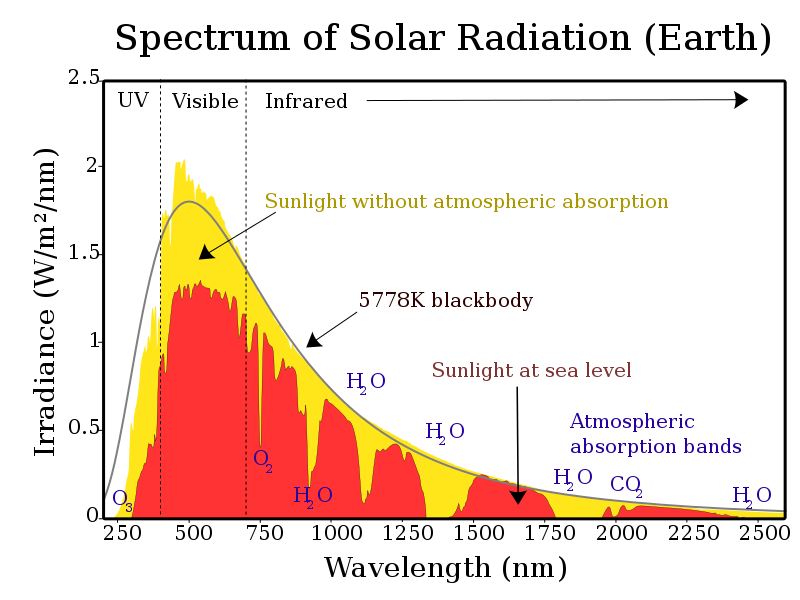Datei:Solar spectrum en.svg
Zur Navigation springen
Zur Suche springen

Größe der PNG-Vorschau dieser SVG-Datei: 800 × 600 Pixel. Weitere aus SVG automatisch erzeugte PNG-Grafiken in verschiedenen Auflösungen: 320 × 240 Pixel | 640 × 480 Pixel | 1.024 × 768 Pixel | 1.280 × 960 Pixel | 2.560 × 1.920 Pixel
Originaldatei (SVG-Datei, Basisgröße: 800 × 600 Pixel, Dateigröße: 49 KB)
Dateiversionen
Klicke auf einen Zeitpunkt, um diese Version zu laden.
| Version vom | Vorschaubild | Maße | Benutzer | Kommentar | |
|---|---|---|---|---|---|
| aktuell | 18:10, 13. Mai 2019 |  | 800 × 600 (49 KB) | Tuvalkin | It's W, not kW, as further discussed: Reverted to version as of 20:57, 21 February 2016 (UTC) |
| 16:13, 25. Feb. 2019 |  | 800 × 600 (49 KB) | Tuvalkin | W → kW, as dicussed | |
| 22:57, 21. Feb. 2016 |  | 800 × 600 (49 KB) | BenRG | Replace 5250°C blackbody (seemingly miscalculated anyway) with standard 5778K blackbody; center-align captions; use Unicode ² instead of SVG superscript to fix rendering problems | |
| 00:21, 8. Jan. 2015 |  | 800 × 600 (50 KB) | Bendhoward | The Y-axis units were changed at some point to W/m^2, which is not correct. The units have been changed back to W/m^2/nm, in accordance with the units of the X-axis. | |
| 00:25, 5. Sep. 2014 |  | 800 × 600 (50 KB) | TxBangert | ... changed ^2 to superscript | |
| 00:18, 5. Sep. 2014 |  | 800 × 600 (50 KB) | TxBangert | fixed minor errors in how Wikipedia renders svg image | |
| 12:28, 4. Sep. 2014 |  | 800 × 600 (50 KB) | TxBangert | Updated the text to bring it in more in line with other European versions of this graph. W/m2/nm on the y axis is wrong. The units are simply W/m2, the x axis is nm. | |
| 16:50, 4. Mär. 2013 |  | 800 × 600 (50 KB) | Arbeck | Typo corrected - Atmosphere | |
| 17:44, 14. Feb. 2013 |  | 800 × 600 (50 KB) | Arbeck | Typo corrected: visible | |
| 17:44, 14. Feb. 2013 |  | 800 × 600 (50 KB) | Arbeck | Typo correctedvisible |
Dateiverwendung
Die folgende Seite verwendet diese Datei:
Globale Dateiverwendung
Die nachfolgenden anderen Wikis verwenden diese Datei:
- Verwendung auf ca.wikipedia.org
- Verwendung auf el.wikipedia.org
- Verwendung auf en.wikipedia.org
- Verwendung auf es.wikipedia.org
- Verwendung auf eu.wikipedia.org
- Verwendung auf hak.wikipedia.org
- Verwendung auf hi.wikipedia.org
- Verwendung auf hu.wikipedia.org
- Verwendung auf ig.wikipedia.org
- Verwendung auf ja.wikipedia.org
- Verwendung auf ms.wikipedia.org
- Verwendung auf sk.wikipedia.org
- Verwendung auf te.wikipedia.org
- Verwendung auf uz.wikipedia.org
- Verwendung auf vi.wikipedia.org









